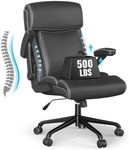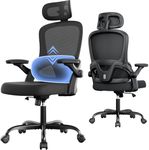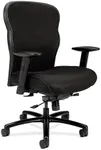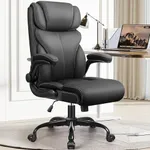Buying Guide for the Best Office Chair For Heavy People
Choosing the right office chair is crucial, especially for heavier individuals, as it directly impacts comfort, support, and long-term health. The right chair should provide stability, durability, and ergonomic support to ensure you can work comfortably for extended periods. When shopping, focus on features that enhance strength, adjustability, and comfort, and always consider how the chair will fit your body and daily routine.Weight CapacityWeight capacity refers to the maximum weight the chair is designed to safely support. This is important because using a chair that can't handle your weight can lead to discomfort, reduced lifespan of the chair, or even safety risks. Chairs typically come in standard, mid-range, and high-capacity options. Standard chairs often support up to 250 pounds, mid-range chairs up to 350 pounds, and heavy-duty chairs can support 400 pounds or more. To pick the right one, always choose a chair with a weight capacity that exceeds your body weight to ensure safety and durability.
Seat Width and DepthSeat width and depth determine how much space you have to sit comfortably. A wider and deeper seat provides more room, which is especially important for heavier users to avoid feeling cramped. Standard seats may feel too narrow, while extra-wide seats offer more comfort and support. When choosing, make sure the seat is wide and deep enough for you to sit without pressure on your hips or thighs, and that your back is supported by the backrest.
Frame and Base StrengthThe frame and base are the structural parts of the chair that bear your weight. Stronger materials like reinforced steel or heavy-duty aluminum are more durable and stable than plastic. Some chairs have a five-point base for extra stability. For heavier users, it's best to look for chairs with a metal frame and a sturdy base to prevent wobbling or breakage over time.
AdjustabilityAdjustability refers to how much you can change the chair's settings, such as seat height, armrest position, tilt, and lumbar support. This is important because it allows you to customize the chair to fit your body and sitting style, which helps prevent discomfort and strain. Some chairs offer basic adjustments, while others allow for more fine-tuning. If you spend long hours at your desk, look for a chair with multiple adjustment options so you can find the most comfortable and supportive position.
Cushioning and UpholsteryCushioning and upholstery affect how comfortable the chair feels and how well it holds up over time. Thicker, high-density foam cushions provide better support and last longer, while thin or low-quality padding can flatten quickly. Upholstery materials like mesh, fabric, or leather each have their pros and cons: mesh is breathable, fabric is soft, and leather is durable and easy to clean. Choose a chair with firm, supportive cushioning and a material that suits your comfort and maintenance preferences.
Lumbar and Back SupportLumbar and back support help maintain the natural curve of your spine, reducing the risk of back pain. Some chairs have built-in lumbar support, while others offer adjustable options. For heavier users, strong and well-designed back support is essential to prevent slouching and discomfort. When picking a chair, make sure the backrest supports your lower back and encourages good posture.
ArmrestsArmrests provide support for your arms and shoulders, reducing strain during long periods of sitting. Adjustable armrests are especially helpful, as they can be moved up, down, or sideways to fit your body. For heavier users, wider and padded armrests can add extra comfort. Choose a chair with armrests that can be adjusted to your preferred height and width, so your arms can rest comfortably while you work.


















